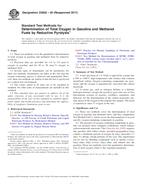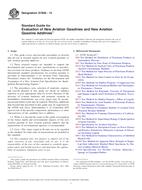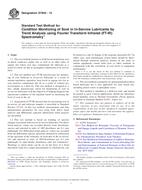We need your consent to use the individual data so that you can see information about your interests, among other things. Click "OK" to give your consent.
ASTM D5622-95(2011)
Standard Test Methods for Determination of Total Oxygen in Gasoline and Methanol Fuels by Reductive Pyrolysis
STANDARD published on 1.5.2011
The information about the standard:
Designation standards: ASTM D5622-95(2011)
Note: WITHDRAWN
Publication date standards: 1.5.2011
SKU: NS-31921
The number of pages: 5
Approximate weight : 15 g (0.03 lbs)
Country: American technical standard
Category: Technical standards ASTM
The category - similar standards:
Annotation of standard text ASTM D5622-95(2011) :
Keywords:
carbon dioxide, carbon monoxide, di-isopropyl ether, ethanol, ethyl tert-butyl ether, isobutanol, isopropanol, methanol, methyl tert-butyl ether, n-butanol, n-propanol, oxygen, reductive pyrolysis, sec-butanol, tert-butanol, tert-amyl methyl ether, Pyrolysis, Reductive pyrolysis, TAME (tert-amyl methylether), Total oxygen, Automotive engine fuels/oils, Butanol (sec/tert/n), Carbon dioxide, Carbon monoxide (CO), Di-isopropyl ether, ETBE (ethyl tert-butyl ether), Ethanol
Additional information
| Significance and Use | ||||||||||||
|
These test methods cover the determination of total oxygen in gasoline and methanol fuels, and they complement Test Method D4815, which covers the determination of several specific oxygen-containing compounds in gasoline. The presence of oxygen-containing compounds in gasoline can promote more complete combustion, which reduces carbon monoxide emissions. The Clean Air Act (1992) requires that gasoline sold within certain, specified geographical areas contain a minimum percent of oxygen by mass (presently 2.7 mass %) during certain portions of the year. The requirement can be met by blending compounds such as methyl tertiary butyl ether, ethyl tertiary butyl ether, and ethanol into the gasoline. These test methods cover the quantitative determination of total oxygen which is the regulated parameter. |
||||||||||||
| 1. Scope | ||||||||||||
|
1.1 These test methods cover the quantitative determination of total oxygen in gasoline and methanol fuels by reductive pyrolysis. 1.2 Precision data are provided for 1.0 to 5.0 mass % oxygen in gasoline and for 40 to 50 mass % oxygen in methanol fuels. 1.3 Several types of instruments can be satisfactory for these test methods. Instruments can differ in the way that the oxygen-containing species is detected and quantitated. However, these test methods are similar in that the fuel is pyrolyzed in a carbon-rich environment. 1.4 The values stated in SI units are to be regarded as standard. No other units of measurement are included in this standard. 1.5 This standard does not purport to address all of the safety concerns, if any, associated with its use. It is the responsibility of the user of this standard to establish appropriate safety and health practices and determine the applicability of regulatory limitations prior to use. |
||||||||||||
| 2. Referenced Documents | ||||||||||||
|
Similar standards:
Historical
1.10.2012
Historical
15.10.2013
Historical
1.12.2012
Historical
1.4.2013
Historical
15.6.2013
Historical
15.6.2013
We recommend:
Technical standards updating
Do you want to make sure you use only the valid technical standards?
We can offer you a solution which will provide you a monthly overview concerning the updating of standards which you use.
Would you like to know more? Look at this page.



 ASTM D7821-12
ASTM D7821-12 ASTM D7826-13
ASTM D7826-13 ASTM D7844-12
ASTM D7844-12 ASTM D7845-13
ASTM D7845-13 ASTM D7862-13
ASTM D7862-13 ASTM D7872-13
ASTM D7872-13
 Cookies
Cookies
